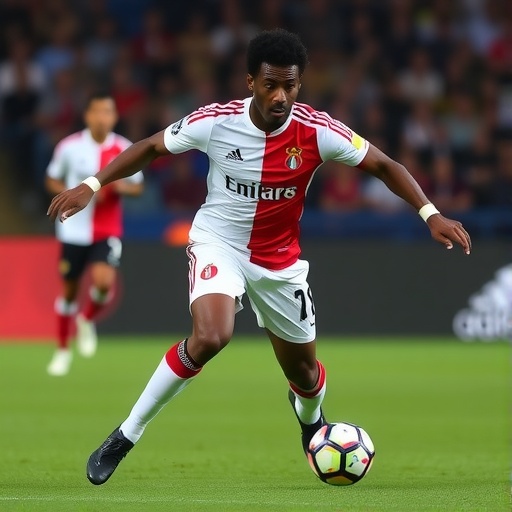In a heartbreaking turn for US soccer enthusiasts, Tim Weah, the dynamic winger for Marseille, limped off the pitch after delivering his first assist for the club, contributing to a narrow 2-1 defeat against Lens in the French Ligue 1 on Saturday night. The injury, which occurred late in the match, has sparked immediate concerns about the 24-year-old’s availability for both club and international duties, casting a shadow over Marseille’s European ambitions and the US Men’s National Team’s preparations.
Weah’s Flash of Brilliance Ignites Marseille’s Attack
Tim Weah‘s integration into Marseille’s squad has been one of the most anticipated storylines in Ligue 1 this season. The son of soccer legend George Weah, Tim arrived from Lille on a free transfer in the summer, bringing his pace, dribbling skills, and international pedigree to the Velodrome. In his debut season with Marseille, Weah had been gradually earning starts, showcasing glimpses of his potential against top-tier defenses.
Against Lens, a team known for its gritty, counter-attacking style under manager Franck Haise, Weah finally broke through. In the 28th minute, he received the ball on the right flank, evaded a challenge from Lens defender Kevin Danso, and whipped in a precise cross to Pierre-Emile Højbjerg, who headed home to give Marseille a 1-0 lead. It was Weah’s first assist in a Marseille shirt, a moment that sent the home crowd into a frenzy and highlighted why US soccer scouts have long viewed him as a cornerstone for the national team.
“Tim’s delivery was world-class,” said Marseille coach Roberto De Zerbi in his post-match press conference. “He’s adapting quickly to our system, and that assist showed his vision and speed. We’re building around players like him to challenge for the title.” Weah himself, speaking briefly before the injury update, posted on social media: “Proud to contribute today. Let’s keep pushing! #OM #USMNT.”
This assist not only boosted Marseille’s morale but also underscored Weah’s growing influence. Statistically, Weah had been averaging 1.2 key passes per game in his limited starts, according to Opta data, placing him among the top wingers in the league for creative output despite playing only 45% of available minutes.
Lens Mounts a Resilient Comeback in Rain-Soaked Clash
The match at Stade Vélodrome was a tactical chess game from the outset, with Lens arriving as underdogs but with a formidable record on the road. Lens, sitting seventh in the Ligue 1 standings with 22 points from 14 games, had won four of their last five away fixtures, thanks to their high-pressing game and clinical finishing led by forward Elye Wahi.
Marseille dominated possession in the first half, holding 62% of the ball and registering seven shots on target. However, Lens equalized just before halftime through a deflected strike from Angelo Fulgini in the 42nd minute, capitalizing on a rare lapse in Marseille’s midfield. The second half saw the intensity ramp up, with both teams trading chances. Marseille’s Amine Harit nearly restored the lead in the 65th minute, but his effort was cleared off the line by Facundo Medina.
The decisive blow came in the 78th minute when Wahi latched onto a long ball from Jonathan Gradit, outpacing Marseille’s defense to slot past goalkeeper Pau López for a 2-1 lead. Lens defended stoutly thereafter, frustrating Marseille’s attempts to equalize. The final whistle brought groans from the 65,000-strong crowd, marking Marseille’s third home loss of the season and dropping them to fourth place, six points behind leaders Paris Saint-Germain.
Key stats from the game paint a picture of a closely contested affair: Marseille had 18 total shots to Lens’s 9, but Lens converted their opportunities with ruthless efficiency, boasting a 22% shot-to-goal conversion rate compared to Marseille’s 6%. This resilience is emblematic of Lens’s season, where they’ve punched above their weight, drawing praise from Ligue 1 pundits for their organization and counter-threats.
The Moment of Dread: Unpacking Tim Weah‘s Injury Scare
As the clock ticked into stoppage time, with Marseille pressing for an equalizer, disaster struck for Tim Weah. In a desperate chase for a loose ball near the corner flag, Weah twisted awkwardly after a challenge from Lens midfielder David Pereira da Costa. He immediately clutched his right ankle, signaling to the bench as medical staff rushed on. After a brief assessment, he was stretchered off, replaced by substitute Ulisses Garcia in the 92nd minute.
Initial reports from Marseille’s medical team describe the injury as a suspected ankle sprain, potentially involving ligament damage. Weah was seen limping heavily toward the tunnel, and club sources confirmed he underwent scans immediately after the match. No official timeline has been released, but similar injuries in Ligue 1 this season have sidelined players for 4-6 weeks on average, per the French Football Federation’s injury database.
For US soccer fans, this injury hits hard. Weah has been a regular in the USMNT setup, earning 28 caps and scoring three goals since his debut in 2019. His versatility on the wings makes him indispensable, especially with Christian Pulisic often deployed centrally. “We’re monitoring Tim closely,” said USMNT coach Gregg Berhalter via a team statement. “He’s a key part of our attacking depth, and we hope for a swift recovery.”
The incident has reignited discussions about player welfare in high-stakes leagues. Weah’s injury adds to a growing list for Marseille, with midfielders like Valentín Carboni already out long-term. Analysts point to the physical demands of Ligue 1, where tackles average 22 per game—higher than the Premier League’s 20—contributing to a 15% rise in ankle injuries league-wide this year.
Marseille’s Season Hangs in the Balance Amid Injury Woes
Marseille’s campaign has been a rollercoaster, blending dazzling attacking football with defensive vulnerabilities. Under De Zerbi, the Italian tactician who joined from Brighton, the team has emphasized possession-based play, averaging 55% ball control per match. Yet, their record stands at 7 wins, 4 draws, and 3 losses, with goals conceded rising to 1.4 per game—a concern as they eye Champions League qualification.
Weah’s injury exacerbates an already strained squad. The club has dealt with absences of key players like Chancel Mbemba (knee) and Ismaïla Sarr (hamstring), forcing De Zerbi to rotate heavily. In Ligue 1, Marseille’s home form remains strong, with only two losses at the Velodrome, but away games have yielded just two victories. The Lens defeat highlights ongoing issues in transition play, where they’ve been caught out 12 times this season, per Wyscout analytics.
Financially, Marseille is stable, backed by owner Frank McCourt’s investments, but the pressure is on to secure a top-four finish for UEFA revenue. Weah’s contribution, even in limited minutes, has been vital; his assist against Lens was the team’s 15th from open play, underscoring his role in breaking down compact defenses like Lens’s.
Looking at broader Ligue 1 trends, the league’s competitiveness is at an all-time high, with five teams within eight points of the top spot. Lens’s win propels them into contention for European spots, their third victory in four games boosting morale ahead of a tough festive schedule.
US Soccer’s Rising Star Faces Setback: Implications for National Team
Tim Weah’s injury reverberates beyond Marseille, striking at the heart of US soccer’s ambitions. The USMNT, under Berhalter, is in the midst of World Cup qualifying preparations for 2026, co-hosted by the USA, Canada, and Mexico. Weah’s pace and crossing ability are crucial for a team that relies on wide play to unlock defenses, as evidenced by his assist in the recent 2-0 win over Mexico in the CONCACAF Nations League.
With the next international window in March 2024, Weah’s recovery timeline is critical. The US team has depth on the wings with players like Weston McKennie and Brenden Aaronson, but Weah’s unique blend of athleticism—clocking top speeds of 34 km/h in Ligue 1—sets him apart. Injury data from US Soccer shows wingers like Weah miss an average of 20% of games due to soft-tissue issues, a statistic that underscores the need for better load management.
Experts are weighing in on the bigger picture. “Tim’s development in France is pivotal for US soccer’s golden generation,” noted ESPN analyst Herculez Gomez. “An injury like this could disrupt his rhythm, but if he bounces back strong, it might even fuel his motivation for the World Cup.” The USMNT’s recent form, with four wins in their last five, positions them as favorites in CONCACAF, but depth is key against tougher opponents like England in friendlies.
For Weah personally, this setback tests his resilience. His career trajectory—from Celtic to Lille to Marseille—has been marked by perseverance, including overcoming a 2020 ACL tear that sidelined him for eight months. Off the field, Weah is active in philanthropy, supporting soccer academies in Liberia through his family’s foundation, adding depth to his public persona.
As Marseille prepares for their next Ligue 1 clash against Toulouse in two weeks, all eyes will be on Weah’s rehabilitation. Club physios report positive early signs, with swelling reduced, suggesting a potential return before the end of January. For US soccer, his swift recovery could solidify the team’s attacking options, ensuring they enter 2024 qualifiers with momentum.
In the interim, Marseille must rally without their US star, leaning on youth prospects like 19-year-old midfielder Eliesse Ben Seghir. The Ligue 1 season’s intensity shows no signs of letting up, and with Champions League spots on the line, every point—and every player—counts. Fans on both sides of the Atlantic are holding their breath, hoping Weah’s injury proves to be a mere blip in an otherwise promising career.








